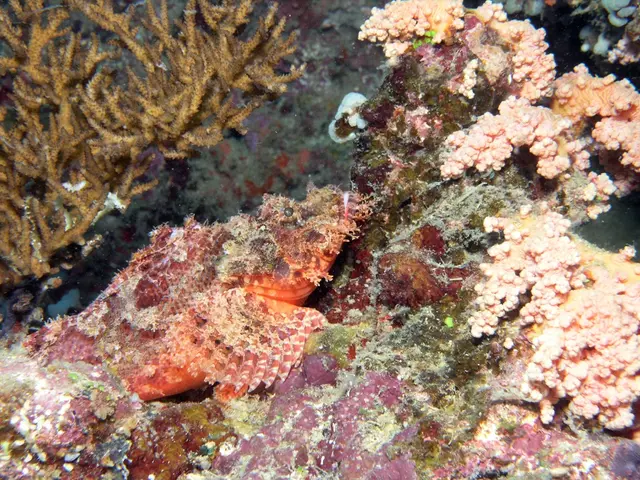Strategies of Ant Interaction: Information Exchange in the Ant Kingdom
Ants are the epitome of success and organization amongst Earth's creatures, not just because of their tiny size, but due to their complex behaviors, sizeable colonies, and seamless teamwork – all without much form of spoken language like humans. If you're intrigued about how these six-legged powerhouses communicate, read on!
This piece delves into the various ways ants manage to share information within their colonies, by using chemical signals (pheromones), touch, vibrations, and sound. With this intricate communication system, they can organize attacks, locate food, warn of danger, and maintain colony structure. Let's explore how it all works!
1. Pheromone Party: The Power of Smell
Pheromones, chemical signals that relay information between colony members, are the primary way ants communicate. Different pheromones have specific meanings, and ants have highly sensitive antennae that detect these scents.
Fun and Function
Trail Markers – Ants leave pheromone trails to lead others to a food source. With more ants following, the trail strengthens, while weak trails fade.
Alarm Bells – When an ant is threatened, it releases an alarm pheromone to alert others to defend or retreat.
Recognition – These pheromones help ants identify colony members and distinguish them from intruders.
Love Lures – Queen ants use pheromones to influence worker behavior and control colony reproduction.
Gone, but not Forgotten – Dead ants release death pheromones, promoting workers to remove them from the colony.
Trail Magic
When a forager ant discovers food, it returns to the colony while leaving pheromone scents. Other ants detect these and follow the trail. If the food source is bountiful, more ants follow, reinforcing the trail. If the food runs out, the trail lessens, and ants stop following it.
Enrichment: How do ants use pheromones to communicate effectively? Ants use different types of pheromones with specific meanings, and they can detect these scents through their highly sensitive antennae. By reinforcing successful food trails with more ants following, they ensure that other ants quickly find sources of food.
2. Pat-on-the-Back: Tactile Communication
Ants also communicate using tactile signals, often via antennae touching and body contact.
Two's Company, Three's a Crowd
Touch Greeting – Ants tap each other with their antennae to recognize nestmates, assess roles, and communicate.
Food Swap Dance – Ants pass liquid food mouth-to-mouth while exchanging chemical cues about food quality and colony needs.
Royal Couple Time – Worker ants tend and feed the queen while receiving pheromonal signals about colony health.
Enrichment: In addition to pheromones, ants communicate with each other through tactile signals like antennae tapping and food sharing. These interactions not only pass on information but also strengthen relationships within the colony.
3. Shaking Things Up: Vibrations and Sounds
Although ants lack ears, they can generate and detect vibrations. Some species use stridulation—a sound made by rubbing body parts together.
Let the Shaking Begin
Shaking for Alarms – Some ants create vibrations to sound the alarm when danger is near.
SOS Signals – Ants in distress (like those buried or trapped) produce sounds to signal other ants for assistance.
Mating Calls – Certain ant species use vibrations to court potential mates.
Enrichment: Leafcutter ants use stridulation while cutting leaves, demonstrating how they use sound to communicate effectively while working together.
4. Show Me the Way: Visual Communication
Though ants rely more on pheromones and touch than vision, some species have large eyes to recognize landmarks, colony members, and threats.
Sight and Stance
Some ants use body postures (such as raised abdomens) to signal aggression to other ants. Army ants and weaver ants rely more on sight than scent when hunting prey.
Enrichment: While vision is not their primary means of communication, some ant species use body postures and a higher visual reliance for navigation, hunting, and colony defense.
5. Aligned Goals: Teamwork and Colony Coordination
The efficiency of ant colonies stems from their communication methods that enable them to stay organized.
Food Scouts and Trail Guides
Scouts locate food and set pheromone trails to lead others to the find. When more ants discover successful food trails, these trails become stronger and guide more ants to the find.
Emergency Response
If a predator or rival ant colony attacks, alarm pheromones signal a coordinated response among ant soldiers.
Building and Repair with Teamwork
Workers use pheromones to coordinate construction projects, determining where tunnels and chambers should be built. Dead or injured ants release chemicals to signal the need for removal and maintain proper colony hygiene.
Enrichment: Ant colonies are efficient due to their communication skills, coordinating activities such as food gathering, defense, and nest construction through various methods, including pheromone trails and tactile communication.
6. Bright Minds: Studying Ant Communication
Researchers have examined ant communication by:
Tracking pheromone trails using high-tech sensors to map the trails.
Slow-motion video analysis to observe antennae touching and food sharing closely.
Chemical experiments to test pheromones and observe colonies’ responses.
Enrichment: Scientists have used various techniques, from high-tech sensors to slow-motion videos, to study ant communication. Research continues to provide insights into their complex communication system that could inspire new advancements in robotics, artificial intelligence, and teamwork strategies.
7. Astonishing Ant Facts
Ant colonies that span millions of ants can communicate across large distances through their Sophisticated, multi-layered communication system, allowing them to work together, locate food, guard their nests, and build colonies seamlessly. This teamwork is awe-inspiring, and we can learn much from studying ants.
In extreme situations, some ant species create living rafts during floods by following intricate pheromone trails to stick together and stay afloat until the water recedes.
Other ant species even farm fungi and milk aphids, using pheromones and chemical signals to keep their “livestock” controlled.
Don't forget next time you see a line of ants marching—they might be engaged in their secret language of communication!
- Ants communicate using chemical signals, known as pheromones, to perform various activities such as marking trails to food, alerting others of danger, recognizing colony members, controlling colony reproduction, and signaling the removal of dead ants.
- Tactile communication is another crucial method of transmitting information among ants through antennae touching, body contact, and mouth-to-mouth food sharing.
- Ants generate and detect vibrations to communicate silently, using stridulation (rubbing body parts together) for various purposes like signaling alarm, SOS, or mating calls.
- Some ant species also rely on sight for navigation, hunting, and colony defense by recognizing landmarks, colony members, and threats through large eyes and body postures.
- Ant colonies maintain efficiency through their communication methods that enable organization in activities such as food gathering, defense, and nest construction using pheromone trails and tactile communication.
- Researchers have employed various techniques, like high-tech sensors, slow-motion video analysis, and chemical experiments, to study the complex communication system of ants, gaining insights for possible advancements in robotics, artificial intelligence, and teamwork strategies.
- Ant colonies show awe-inspiring teamwork, communicating across large distances through their multi-layered communication system, which allows them to work together, locate food, protect their nests, and build colonies seamlessly. Some ant species even demonstrate extraordinary capabilities like creating living rafts during floods and farming fungi or milking aphids using pheromones.








